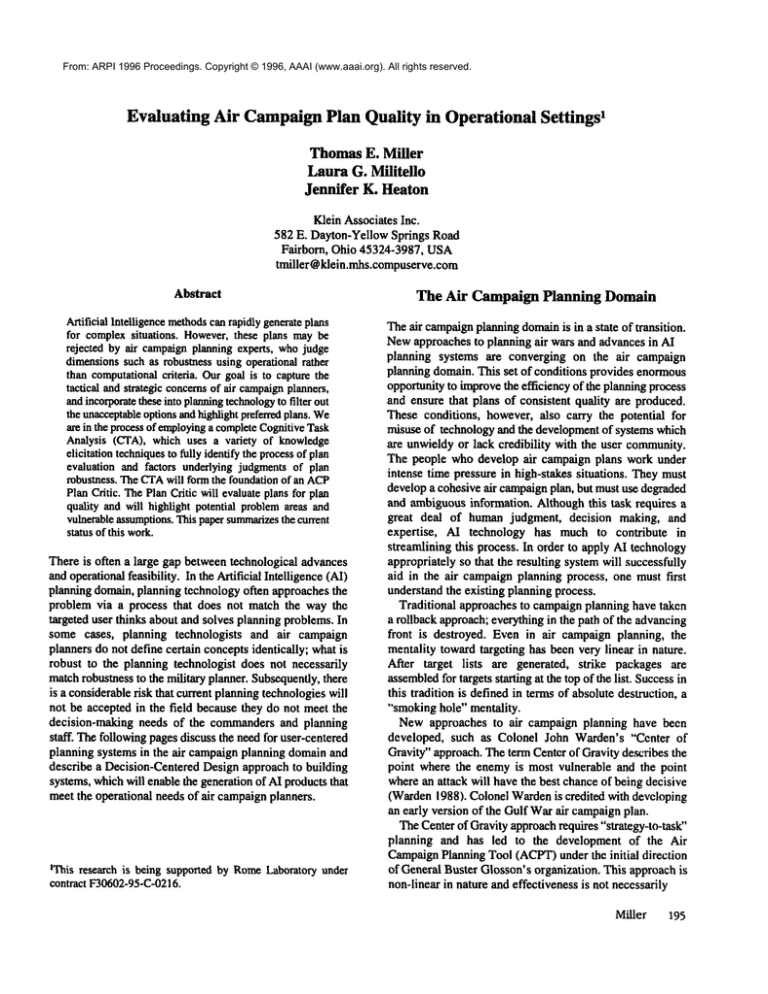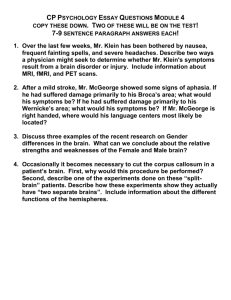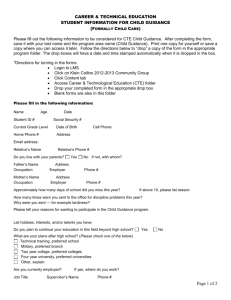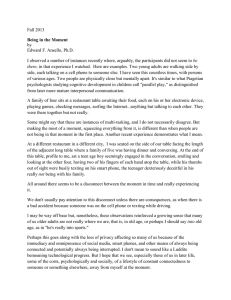
From: ARPI 1996 Proceedings. Copyright © 1996, AAAI (www.aaai.org). All rights reserved.
IEvaluating Air CampaignPlan Quality in Operational Settings
ThomasE. Miller
LauraG. Militello
Jennifer K. Heaton
Klein Associates Inc.
582 E. Dayton-YellowSprings Road
Fairborn, Ohio 45324-3987, USA
tmiller@klein.mhs.compuserve.com
Abstract
Artificial Intelligencemethods
can rapidlygenerateplans
for complexsituations. However,these plans maybe
rejected by air campaignplanning experts, whojudge
dimensionssuch as robustness using operational rather
than computationalcriteria. Ourgoal is to capture the
tactical and strategic concernsof air campaign
planners,
andincorporatethese into planningtechnology
to filter out
the unacceptable
optionsand highlightpreferredplans. We
are in the processof employing
a completeCognitiveTask
Analysis (CTA), which uses a variety of knowledge
elicitation techniquesto fully identifythe processof plan
evaluation and factors underlying judgmentsof plan
robustness. The CTAwill form the foundationof an ACP
PlanCritic. ThePlanCritic will evaluateplansfor plan
quality and will highlight potential problemareas and
vulnerableassumptions.Thispapersummarizes
the current
status of this work.
There is often a large gap betweentechnological advances
andoperationalfeasibility. In the Artificial Intelligence (AI)
planning domain, planning technology often approaches the
problem via a process that does not match the way the
targeted user thinks about and solves planning problems.In
some cases, planning technologists and air campaign
planners do not define certain concepts identically; what is
robust to the planning technologist does not necessarily
matchrobustness to the military planner. Subsequently,there
is a considerablerisk that current planningtechnologieswill
not be accepted in the field because they do not meet the
decision-making needs of the commandersand planning
staff. The followingpages discuss the need for user-centered
planning systems in the air campaignplanning domainand
describe a Decision-Centered Design approach to building
systems, whichwill enable the generationof AI products that
meet the operational needs of air campaignplanners.
1This research is being supported by RomeLaboratory under
contract F30602-95-C-0216.
The Air CampaignPlanning Domain
The air campaignplanningdomainis in a state of transition.
Newapproaches to planning air wars and advances in AI
planning systems are converging on the air campaign
planning domain. This set of conditions provides enormous
opportunity to improvethe efficiency of the planningprocess
and ensure that plans of consistent quality are produced.
These conditions, however, also carry the potential for
misuse of technology and the developmentof systems which
are unwieldyor lack credibility with the user community.
The people who develop air campaign plans work under
intense time pressure in high-stakes situations. Theymust
develop a cohesive air campaignplan, but must use degraded
and ambiguousinformation. Althoughthis task requires a
great deal of human judgment, decision making, and
expertise, AI technology has much to contribute in
streamlining this process. In order to apply AI technology
appropriately so that the resulting systemwill successfully
aid in the air campaignplanning process, one must first
understandthe existing planning process.
Traditional approaches to campaignplanning have taken
a rollback approach; everythingin the path of the advancing
front is destroyed. Even in air campaign planning, the
mentality towardtargeting has been very linear in nature.
After target lists are generated, strike packages are
assembled
for targets starting at the top of the list. Successin
this tradition is defined in terms of absolute destruction, a
"smokinghole" mentality.
Newapproaches to air campaign planning have been
developed, such as Colonel John Warden’s "Center of
Gravity" approach. The term Center of Gravity demribes the
point where the enemy is most vulnerable and the point
wherean attack will have the best chanceof being decisive
(Warden1988). Colonel Wardenis credited with developing
an early version of the Gulf Warair campaignplan.
The Center of Gravity approachrequires "strategy-to-task"
planning and has led to the development of the Air
CampaignPlanning Tool (ACPT)under the initial direction
of General Buster Glosson’s organization. This approach is
non-linear in nature and effectiveness is not necessarily
Miller
]95
From: ARPI 1996 Proceedings. Copyright © 1996, AAAI (www.aaai.org). All rights reserved.
measuredin terms of absolute destruction, but in effective
measures of destruction. For example, in World WarII an
air strategy was to bombentire cities, whereasin the Gulf
War,precise targets such as powerstation transformer yards
were targeted with the intention to disrupt power for
relatively short periods of time.
During Desert Storm, General Glosson focused on
"deconstructing"lraq. Rather than using a rollback strategy
and attempting to achieve absolute destruction, specific
targets were chosen whichwouldmeet the objectives of the
USfor the war. This approach leads to muchmore efficient
and coordinated use of resources during implementation,but
also calls for a morecognitively complexplanning process.
This recent change in the approach to air campaign
planning coupled with advances in the AI arena have created
a situation which is ripe with opportunity to improve the
planning process. Newstrategies toward air campaign
planning have been developed and are being implementedin
someareas of the Air Force community.Also, mature AI
planning tools are being developedthat can be applied in an
operational environment. There is currently tremendous
interest and excitementabout the possibilities of building a
mixedinitiative air campaignplanning systemthat follows
the strategy-to-task approach and takes advantage of AI
planning techniques where appropriate.
Researchers and developers in the planning subarea of
artificial intelligence are interested in developingplan
evaluation technologies as well. The advantages of such a
system are numerous.For example, evaluation of an entire
plan after it is complete can provide valuable feedback on
the quality of the underlying knowledge used by the
automated planner (so that, for example, a knowledge
acquisition aid can improve the knowledge). Another
advantage is that such mechanisms can permit the
comparisonof different planning systems. Also, evaluation
mechanisms
that can be called to quickly checkpartial plans
can aid an automated planner in finding a good solution
without a lot of backtracking. Automatedmethodsof judging
plan quality wouldaid the humanplanner in comparingand
contrasting options and ensure that the humanusing the
systemproducesthe highest quality plan possible.
However,characteristics of a quality, robust air campaign
plan are not well understoodin this domain.Thestrategy-totask approach has been documentedand is used in some
planningcircles. However,the impactof the newstrategy on
plans and on the planning process has not been explored or
documented,but potentially has tremendousimplications for
a Plan Critic. Further, the dynamicsof the planningprocess
are not well understood. Thesefeatures must be understood
if AI planners are to be successful in the operational
community.
A skirmish with the Iraqis in early 1994illustrates the
environmentin whicha mixedinitiative systemwill have to
function. Personnel at Checkmatein the Pentagonwere on
Approach
Cognitive
Task
Analysis
Naturalistic
Decision
Making
N’,
x
\
Concept Maps
Critical Decision
Method
Incident Accounts
/
/
/
/
1
Situation Assessment
Mental Simulation
and Story Building
RPD Model
Decision Requirements
Human-Computer
Interface
Figure I. Decision-Centered Design approach.
196
ARPI
From: ARPI 1996 Proceedings. Copyright © 1996, AAAI (www.aaai.org). All rights reserved.
24-hour workshifts for almost a full week. Events unfolded
rapidly. The Iraqi military was building up in mass to the
north of Kuwait, opposing a small allied force. Checkmate
received a request to developinitial plans for howair power
could be used in the situation. The initial plans were
developedby a small group. This group of planners used a
white board to outline initial assumptionsand objectives.
After the first few hours, they had developeda hand-written
documentthat plan outlined a basic air powerplan. Overthe
next few days, the plan was modified and refined as more
informationwasgathered, as the Iraqi military changedtheir
troop movements, and as objectives from the commanders
changed.
Checkmate planners who took part in this process
described a situation in which there were extreme time
pressures because of the rapid buildup of Iraqi troops. One
planner was only able to catch a 40-minute nap under his
desk over a two-dayperiod. Withthis kind of time pressure,
high stakes, sleep deprivation, and required team effort,
technological advancesthat do not address real concerns in
the planning environment will not be used. Attempts were
madeto use newplanning technologies during this incident,
however, these technologies were not as responsive as
needed in the rapidly changing planning environment.
Our goal is to address issues that will help with the
development,transition, and acceptanceof newtechnologies
for developing quality plans in an operational setting. One
aspect of plan quality that is under examinationis that of
robustness.
Corresponding to our common sense
understanding of this term, a computational definition of
robustness wouldmeasurethe ability of an implementedplan
to achieve its goals, even in the face of changes to the
constraints or conditions that were in effect whenthe plan
wasinitially generated.
Decision-Centered Design Approach
Our approach is a Decision-Centered Design strategy
(illustrated in Figure I) whichcomplements
the technologydriven componentsof AI design planning technologies. This
functional approach identifies the needs of air campaign
planners based on the judgments and decisions they are
required to make. Onceidentified, the primary decision
requirementsused to evaluate plans will form the foundation
of the Plan Critic. Thedecision requirementsare the specific
judgments, diagnoses, and courses of action that planners
generate when they evaluate plans. The decision
requirements are identified using two primary inputs: the
descriptive modelsof Naturalistic Decision Making,and the
specific findings obtained through the Cognitive Task
Analysis (CTA).Naturalistic decision models, such as the
Recognition-Primed Decision model (Klein 1989), are
helpful, but they are not sufficient since they are domain
independent, descriptive modelsof decision making. The
secondinput to decision requirementsis the set of findings
from the CTA.CTAuses different strategies to probe the
waypeople perform tasks, e.g., the cues they rely on, the
patterns they notice, the specific nature of the diagnosesand
decisions they must make, and the reasons why these
decisions are difficult.
The output is a detailed
understanding of howcritical decisions specific to the
domainare reached.
Weare using three approaches in our CTA:the Critical
Decision method(CDM),debriefings, and plan simulations.
CDMinterviews (Klein, Calderwood, & MacGregor1989)
use a set of cognitive probes that havebeen used in a great
manystudies and projects (e.g., Calderwood,Crandall,
Baynes1988; Calderwood,Crandall, &Klein 1987; Crandall
& Calderwood1989; Crandall & Gamblian 1991; Crandail
&Klein 1988: Klein 1989; Klein, Calderwood,& ClintonCirocco 1986; Klein & Thordsen 1988; Thordsen &
Calderwood1989; Thordsenet al. 1988; Thordsen, Klein, &
Wolf 1990; Wolfet al. 1991). The cognitive probes used in
CDM
interviews are designed to help us learn more about
tacit knowledge,
such as the ability of firefighters to rapidly
form a situation assessment and the ability of nurses to
rapidly diagnose a preterm infant in the earliest stages of
infection. The CDM
has been adapted to the air campaign
domain, and the probes are being used to identify which
dimension of plan quality planners use to evaluate air
campaignplans. In manycases domainexperts are unable to
describe the basis for their judgments,but after responding
to the cognitive probes, they gain insights that are new,even
to themselves, about howthey form those judgments.
From our work to date, we have found that debriefing
planners at Checkmatesoon after a national crisis in which
air campaignplans weredevelopedis extremelyfruitful. This
data source is rich becausethe incident remainsfresh in the
planners’ mindsand they can relate their roles in the events.
not just the "war stories" that evolve froma crisis. In the
future, we wouldlike to interview Checkmateplanners as
soon as they are available after a skirmish.
The third knowledgeelicitation methodused in the CTA
is plan simulations (Thordsen, MUiteUo,& Klein 1992;
Crandall, Klein, Militello, &Wolf1994). The interviewee is
askedto evaluate a sampleplan providedby the interviewer.
The interviewees are asked to think aloud as they describe
their evaluation. The interviewer then follows up with probes
pertaining to the use of informational cues and specific
strategies used to evaluate the plan.
Wehave analyzed preliminary interview data to develop
an inventory of plan characteristics that influence plan
quality and robustness. Wealso intend to documentthe
planning process that experiencedplanners use. In a mixed
initiative Plan Critic, it will be important to understand
characteristics
of good plans, how to evaluate those
dimensions, howthe system will need to keep the humanin
the loop, and wherein the system either the humanor the
machineshould be relied upon.
The findings from the CTAwill enable us to design the
Miller
197
From: ARPI 1996 Proceedings. Copyright © 1996, AAAI (www.aaai.org). All rights reserved.
Plan Critic according to the operational needs of air
campaign planners. The value of such a system to this
communityis that the system will automate manyof the
tracking and computationalaspects of the task, so that the
human user may spend more time and resources on the
aspects of the task requiring humanjudgment, skills, and
expertise. This will result in plans that are both more
streamlined and of higher quality.
Preliminary Findings
From our CTAwork to date, we have identified eight
characteristics of good air campaignplans. These themes
comeprimarily from interviews with planners at Checkmate.
In the future, we will be conducting interviews with other
planning communitiessuch as the Air Force componentsof
the Unified Command
(e.g., PACAF)
or significant planners
from the Gulf War. These characteristics
can be
differentiated into characteristics of good plans and
characteristics of planning done by experienced planners.
These characteristics are summarizedbelow:
Characteristics of goodplans:
¯ Objectives must be clearly stated, measurable, and point
toward an end state. Mission statements tend to be very
broad, but specific objectives must be developed to
achieve the overall mission goals.
¯ A goodplan can absorb change in assumptions. The cxtent
to which a plan must be changed if the assumptions are
violated is a measureof robustness.
¯ Actions must achieve stated objectives. A commonerror
is to select targets independent of overall mission
objectives. A goodplan clearly showshowspecific actions
support overall missionobjectives.
¯ A good plan has appropriate phasing. The distinction
betweenprioritizing targets and sequencingin an attack is
sometimes missed.
Characteristics
planners:
of good planning done by experienced
¯ Good planning is done with an appropriate balance
between focusing on the mission objectives and an
awarenessof available resources. Targets should not be on
the target list becausethey couldbe hit, but rather because
they should be hit.
¯ Assumptionsshould be explicitly knownand kept in the
forefront during the planningprocess. This helps maintain
the focus of planning for the assumedcontext.
198
ARPI
¯ The planning process should have a shorter cycle than the
adversary’s planning process.
¯ Goodplans are developedat an appropriate level of detail.
Withoutsufficient detail, it is difficult to evaluatewhether
the plan is feasible. Withtoo muchdetail, humanplanners
cannot visualize the plan and howit will unfold.
These two sets of characteristics affect howa mixed
initiative planningsystemcould be built. Air campaignplans
should exhibit the first set of characteristics, whether
generated by a humanor by an automated or semi-antomated
planning system. The second set of plan characteristics
captures howa goodplanner develops a plan and maynot be
necessary for a strictly automatedplanner. An AI planner
may develop plans very differently
from how human
planners develop plans, taking advantage of the
computationalpowerof the computerand of recent advances
in AI technology.
However, there may be aspects of good planning that
humansexcel at and turning the whole task over to an AI
planner maydegrade plan quality. Thus the importance of
groundingthe design of a Plan Critic on a Cognitive Task
Analysis. If a mixedinitiative systemis to communicate
with
the humanplanner and keep him or her in the loop (in
credible way), then humanplanningstrategies, capabilities,
and approaches must be understood. An AI planner will
support, not supplant, humanplanners.
For example, there are at least two important concerns
relating to the robustnessof a plan. Tobe robust, a plan has
to absorb change. The two primary sources of change are
changesin the goals (i.e., commander’s
intent) and changes
resulting from new information acquired during plan
implementation, such as discovering that someassumptions
were faulty. Thesetwo sources of change are qualitatively
different and should be handled~parately by the Plan Critic.
For a plan to absorb changesin its overall goal, its tasks
should accomplishsubgoals which are broad enoughto cover
changes in the overall goal. For example, a plan’s primary
goal may be the destruction of target A. If the plan
accomplishesthis goal by first destroying nearby SAM
sites,
then destroying target A, it will be accomplishingsubgoals
whichsupport other goals, i.e., the SAM
site. Destroyingthe
SAM
sites supports the destruction of nearby targets such as
targets B & C. If in the middle of plan execution the
commander
changes the primary target to target B, little
effort will havebeen wastedand only minormodificationsto
the plan will be necessary.
There are several ways to measure a plan’s ability to
absorb change in commander’sintent. First, the user can
specify possible alternative objectives. This does not
necessarily need to be an exhaustive list but should be
representative of the kind of newobjectives expected and
shouldcoverthe full rangeof possibilities. Theuser could be
given guidanceas to what to consider in specifying
From: ARPI 1996 Proceedings. Copyright © 1996, AAAI (www.aaai.org). All rights reserved.
alternative objectives. Plans couldbe generatedfor these
alternative objectives and the degreeof overlapwith the
existing plan calculated.Aparticular alternative objective
maygenerateseveralalternative plans. Thealternative plan
with the maximum
degreeof overlapwith the existing one
shouldbe usedfor the calculation.Moresimply,the subgoals
neededto accomplishthe alternative objectives could be
extractedfromthe alternative plans. Robustness
could then
be basedon the percentageof these subgoalsaccomplished
bythe existingplan.
To absorb changein the plan assumptions,the overall
structure andprobabilityof successof the plan shouldnot
rely too heavilyon the assumptions.Onewayof testing this
is to change the assumptionsand replan. A measureof
robustnessis then basedon the degreeto whichthe plan has
changed.Thedifferences betweenthe newplan’s and old
plan’s tasks, their sequencing,andrequired resourcesare
considered. Ther~lanningcan also be performedassuming
that sometasks are completeor committed
by freezingthese
tasks duringreplanning.This is importantbecausethe start
or completionof someearly tasks maycommitthe force to
a particular courseof action, making
the planinflexible.
Tobe consideredrobust, a plan’s probability of success
shouldnot diminishgreatly whenthe assumptionschange.
Thiscomputation
either requiresa simulationto run the plan
through or estimates of the probability of successful
completion the tasks. The differences in the success
probabilities of tasks whenassumptionsare false is also
needed.Giventhe probabilities, propagatingthemthrough
the task network
to the final objectivesis straightforward.
Previousplans in a casebasemayalso be a useful source
of valuable informationwith whichto evaluate a current
plan’srobustness.Anevaluationof a previoussimilar plan’s
robustnesscould be usedto help evaluate a current plan’s
robustness in several ways. For example,a prior plan’s
evaluation could be used as a basis and adjusted for the
current plan. Thereasoningbehindthe evaluation of the
similar plan can be appliedto the currentplan. Theprocess
used to evaluatethe previousplan can be adaptedandused
for the currentplan.
Similarly, parts of previous plans can be used in the
current plan’s evaluation. Therobustnessevaluationfor a
part of a previousplan whichis similar to a part of the
current plan can be used as a basis for evaluation and
adjustmentof the plan. Thereasonsbehindthe evaluationof
a similar part of a previousplan can be examinedto see
whichmightbe applicable. Theprocess usedto evaluate a
similar part of a previousplan mightalso be applicable.
Successprobabilitiesassignedto similar tasks canbe usedas
a basisto estimatethe successprobabilitiesfor a currenttask.
Alternativeobjectivesfor a previoussimilarplan canbe used
to suggestpossiblealternatives to the user for selection.
Probabilities assignedto assumptionsin previoussimilar
planscan be usedas a basis for assumptions
in the current
plan.
In additionto returninga measure
of plan robustness,the
Plan Critic should return the rationale supporting its
evaluation. This should include both the strengths and
weaknesses
of the plan. Usingthis informationthe user, or
the PlanCritic, couldthenimprove
the plan. For example,if
the Plan Critic reports that a plan is weakbecausethere is
onecritical subgoalwhichwill only be accomplished
if each
of a long sequenceof events is successful, then the user
coulddevelopa secondset of eventsin additionto the first
set to accomplish the critical subgoal. Given two
independentmeansof accomplishingthe plan’s goals, it
becomesmuchmorerobust.
Conclusion
Ourworkto date has revealedmanycharacteristicsof robust
plans andthus requirementsfor evaluatingplan robustness.
The next step, apart from continuing to identify
characteristics of robustness,is to explorethe cognitive
processesthroughwhichair campaign
plannersdevelopand
evaluate plans. It is importantto considersuchprocesses
whenbuilding an automatedsystemso that the systemis
groundedin the user’s approachto solving the problem.
Thereis currently a gap betweenAI planningtechnology
andthe needs of users in the operational community.
The
goal of this project is to fill that gapby using a design
strategythat focusesonthe intendeduser, in this casethe air
campaignplanner, while being vigilant to technological
advances.Weare using a Decision-CenteredDesign
approach
to builda planevaluationtool, the PlanCritic. This
entails conductinga thoroughCognitiveTaskAnalysisof the
tasks faced by air campaign
plannersandincorporatingthe
findingsas the foundationof the tool. Theresult will be a
plan evaluation tool that supports the humanplanning
processin an operationalsetting. Successfuldevelopment
of
the Plan Critic will allowair campaign
plannersto develop
robust plans morequicklyandeffectively.
References
Calderwood,
R., Crandall, B. W., andBaynes,T. H. 1988.
Protocols of expert/novicecommand
decision makingduring
simulatedfire groundincidents, KATR-858-88-02Z.
Yellow
Springs,OH:KleinAssociates,Inc. Preparedundercontract
MDA903-85-C-0327
for the U.S. ArmyResearchInstitute
for the BehavioralandSocial Sciences,Alexandria,VA.
Calderwood,
R., Crandall, B. W., and Klein, G. A. 1987.
Expertand novice firegroundcommand
decisions, AD-B
154
224. Alexandria,VA:DefenseLogistics Agency.
Crandall, B., and Calderwood,
R. 1989.Clinical assessment
skills of experienced
neonatalintensivecare nurses.Yellow
Springs,OH:KleinAssociatesInc. Final Reportpreparedfor
Miller
199
From: ARPI 1996 Proceedings. Copyright © 1996, AAAI (www.aaai.org). All rights reserved.
the National Center for Nursing, NIHunder Contract No.
1 R43 NR0191101.
Crandall, B., and Gamblian,V. 1991. Guideto early sepsis
assessment in NICU.Fairborn, OH:Klein Associates Inc.
Crandail, B., and Klein, G. A. 1988. Key componentsof
MISperformance. Yellow Springs, OH: Klein Associates
Inc. Report prepared for Standard Register, Dayton,OH.
Crandall, B., Klein, G., Militello, L. and Wolf, S. 1994.
Toolsfor applied cognitive task analysis. Final report. The
Naval Personnel Research and DevelopmentCenter, San
Diego, CA.
Klein, G. A. 1989. Recognition-primeddecisions. In W.B.
Rouse (Ed.), Advances in man-machinesystem research,
Vol. 5:47-92. Greenwich.CT: JAI Press, Inc.
Klein, G. A., Calderwood,R., and Clinton-Cirocco, A. 1986.
Rapiddecision makingon the fire ground. In Proceedingsof
the 30th Annual HumanFactors Society, 576-580. Dayton,
OH:HumanFactors Society.
Klein, G.A., Calderwood, R., and MacGregor, D. 1989.
Critical decision method for eliciting knowledge. IEEE
Transactions on Systems. Man,and Cybernetics 19:462-472.
Klein, G. A., and Thordsen, M. 1988. Use of progressive
deepeningin battle management.
In Proceedingsof the 11 th
Biennial DoDPsychology Conference, 301-305. Colorado
Springs, CO: USAir Force Academy.
Thordsen, M. L., and Calderwood, R. 1989. Protocol
analysis of flight crew decision makingduring simulated
200
ARPI
malfunctions. Yellow Springs, OH:Klein Associates Inc.
Prepared under Order No. A72145Cfor the NASA/Ames
Research Center, Moffett Field, CA.
Thordsen, M., Klein, G. A., Michel, R., and Sullivan, E.
1988. Methodsfor providing direct feedback about decision
processes for command-and-controlclassroom exercises,
KATR-863-8806Z.Yellow Springs, OH: Klein Associates
Inc. Prepared under contract MDA903-86-C-0170
for the U.
S. ArmyResearch Institute for the Behavioral and Social
Sciences, Alexandria, VA.
Thordsen,M. L., Klein, G. A., and Wolf, S. 1990. Observing
team coordination within Armyrotary-wing aircraft crews.
contract MDA903-87-C-0523
for the U.S. ArmyResearch
Yellow Springs, OH:Klein Associates Inc. Prepared under
Institute, Aviation Research and DevelopmentActivity, Ft.
Rueker, AL.
Thordsen, M. L., Militello, L. G., and Klein, G. 1992.
Cognitive task analysis of critical team decision making
during multiship engagements. Fairborn, OH: Klein
Associates Inc. Prepared under PO No. RI-82264X for
Williams AFB, AZ.
Warden, J. A. 1988. The Air Campaign: Planning for
Combat. Washington, DC: National Defense University
Press.
Wolf, S., Klein, G., Thordsen, M., & Klinger, D. 1991.
Factors affecting the decision makingof fire direction
officers. Yellow Springs, OH: Klein Associates Inc.
Prepared under contract DAAAi5-90-C-1054
for the U. S.
ArmyBallistics Research Laboratory.






